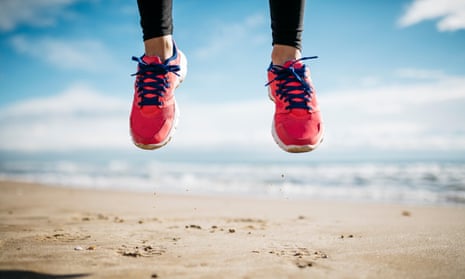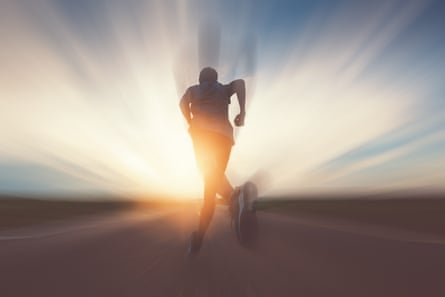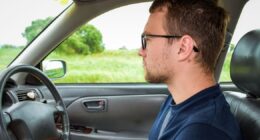
Chasing the runner’s high: the elusive buzz scientists are still figuring out
The promise of a runner’s high hovers tantalisingly on the horizon, but pinning down exactly what it is – and where else you can get it – is tricky
I’m a reluctant runner. Two or three times a week, I stagger around the streets and pathways of my neighbourhood, motivated only by the company of my running buddy and by the anticipation of the food I will enjoy when I get home.
The idea of a runner’s high hovers tantalisingly on the horizon, like a neurochemical mirage. Maybe once on a longer run I felt it, like my feet had grown wings and for the first time in my running life I actually wanted to keep going.
The promise of an exercise high sounds like a cruel joke made up by personal trainers, but some runners talk of drug-like addiction, and scientists think there is something there: they’re just not exactly sure what it is.
Neuroscientist Dr Hilary Marusak from Wayne State University in Detroit, US, is a runner who has taken chasing the runner’s high to the next level. Her research explores how exercise interacts with brain chemistry, with a view to ultimately making use of that knowledge to help understand and treat mental health disorders.
Pinning down exactly what “runner’s high” is is tricky. Not everyone who runs seems to experience it, but those who do talk about a feeling of wellbeing, almost euphoria, kicking in at some point in their exercise – it may be after a few minutes, it may be after 20 minutes. And it doesn’t just have to be running: it can happen with other strenuous exercise such as bicycling, swimming or even rock-climbing, but doesn’t seem to happen with team sports. What’s not yet understood is how long it lasts, why some people get it but others don’t, what triggers it, and what’s going on in the body when it happens.
Marusak says the runner’s high has long been thought to be an effect of endorphins, which are opioid-like hormones that the body releases in response to stress or pain to relieve that pain. But “the past couple of decades have really refuted that idea with some interesting scientific research”, Marusak says.
For example, if a drug like naltrexone is used to block the effects of those homegrown endorphins, people still experience runner’s high, she says. Endorphins are also quite large molecules, and they can’t cross the blood-brain barrier – the special lining of blood vessels in the brain that protects the brain from chemical or biological harm – so their effects are felt much more at the regional level: the nerve endings in muscles, for example. Both these suggest that endorphins are likely to play a limited role in runner’s high.
Another system that might be involved is the endocannabinoid system which, as its name suggests, is the one that cannabis interacts with. Endocannabinoids are small enough to get across the blood-brain barrier, where they interact with receptors that control a range of functions, including mood and inflammation.
READ RELATED: I couldn’t stop Parcelforce delivering my £2,000 wedding dress to a scammer

Dr Francis Chaouloff, a neuroscientist at the Neurocentre Magendie – a research institute in Bordeaux, France – has been exploring the role of endocannabinoids in exercise, by studying a key endocannabinoid receptor called CB1 in mice. “If you remove the CB1 receptor or if you block the CB1 receptor, you will see that the mouse will run less,” Chaouloff says. He thinks this could relate to the fact that CB1 receptors are found in particular in a part of the brain associated with reward.
But this speaks more to mice being motivated enough to poke their nose at a target that then lets them hop on the wheel for a jog. That motivation can be quantified in mice, but it’s a lot harder to study how they feel while they’re doing it, and whether they’re getting the “high”. “They never fill questionnaires,” Chaouloff jokes. What his research does suggest is that endocannabinoids are important in motivating us to run, and may also be the reason why regular runners really miss it when they stop running; there’s a sort of withdrawal effect when those endocannabinoids aren’t released.
Lou Clifton is an internationally competitive trail runner whose successes include being the first in her age group and first Australian across the line in the gruelling 160km Ultra-Trail du Mont-Blanc ultramarathon in France last year. She runs for lots of reasons – the sense of achievement, being with friends, being out in nature, testing her limits – but she’s unsure about whether there’s a specific “high” that she notices when she runs.
“I guess generally when I’m running, there’ll be a point where I settle into a bit of a groove and it’s quite comfortable,” she says. “When I finish a race I’ve certainly had that high, because I think that then you have that whole elation of finishing and the adrenaline.” She has also experienced the lows of not running, when illness or injury has prevented her from getting out for even an easy 10km trot.
One thing that seems to be clear is that the intensity of exercise matters for triggering the runner’s high, Marusak says.
“It seems like moderate activity – greater than 50% maximum heart rate – is better at getting a cannabinoid boost than lighter exercise, like a brisk walk,” she says. “We do know that they are synthesised on demand in response to a stressor and an exercise is certainly a stressor.” But it’s not clear whether the more intense the exercise, the more intense the high.
As a runner herself, Marusak also wants to know how to make the most of that high after the run, and so how long it will last. “If I’ve got an exam or something I have to do at work, I want to time my exercise so I continue to have those brain benefits, but does it need to be within the hour or can it be a couple of hours later?”
There are far more questions than answers about this tantalising but elusive phenomenon. But with even seasoned runners admitting that at least the first few minutes of a run can be hard and unpleasant, maybe we don’t need to look this gift horse in the mouth. Anything that gets us off the sofa and out the door for physical activity is a good thing.
Source: Health & wellbeing | The Guardian





